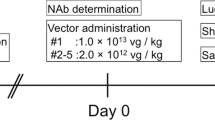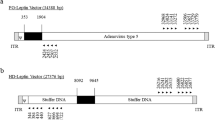Abstract
Naked plasmid DNA (pDNA) injection could become an alternative procedure to viral and nonviral gene delivery systems. We have previously shown that Epstein–Barr virus (EBV)-based plasmid vectors containing the EBV nuclear antigen 1 (EBNA1) gene and the oriP sequence enable quite high and long-lasting expression in various in vitro and in vivo transfection systems. The EBV-based plasmids were intravenously injected into mice via their tail vein under high pressure. A large amount of the marker gene product was expressed in the liver; as much as 320 μg of luciferase was demonstrated per gram of liver at 8 to 24 h after a single injection with 10 μg of DNA. More than 70% of liver cells stained with X-gal when β-gal gene was transferred. The expression level was significantly higher than that obtained by conventional pDNA lacking the EBNA1 gene and oriP. On day 35 after the transfection, the expression from the EBV-based plasmid was approximately 100-fold stronger than the conventional pDNA gene expression. Both the EBNA1 gene and oriP are a prerequisite for the augmentation of the transfection efficiency. These results suggest that the intravascular transfection with naked EBV-based plasmid may provide a quite efficient, simple and convenient means to transduce therapeutic genes in vivo into the liver. Gene Therapy (2001) 8, 1508–1513.
This is a preview of subscription content, access via your institution
Access options
Subscribe to this journal
Receive 12 print issues and online access
$259.00 per year
only $21.58 per issue
Buy this article
- Purchase on Springer Link
- Instant access to full article PDF
Prices may be subject to local taxes which are calculated during checkout






Similar content being viewed by others
References
Wolff JA et al. Direct gene transfer into mouse muscle in vivo Science 1990 247: 1465–1468
Baumgartner I, Isner J . Somatic gene therapy in the cardiovascular system Annu Rev Physiol 2001 63: 427–450
Lin H et al. Expression of recombinant genes in myocardium in vivo after direct injection of DNA Circulation 1990 82: 2217–2221
Meyer KB et al. Intratracheal gene delivery to the mouse airway: characterization of plasmid DNA expression and pharmacokinetics Gene Therapy 1995 2: 450–460
Choate KA, Khavari PA . Direct cutaneous gene delivery in a human genetic skin disease Hum Gene Ther 1997 8: 1659–1665
Hickman MA et al. Gene expression following direct injection of DNA into liver Hum Gene Ther 1994 5: 1477–1483
Budker V, Zhang G, Knechtle S, Wolff JA . Naked DNA delivered intraportally expresses efficiently in hepatocytes Gene Therapy 1996 3: 593–598
Zhang G et al. Expression of naked plasmid DNA injected into the afferent and efferent vessels of rodent and dog livers Hum Gene Ther 1997 8: 1763–1772
Liu F, Song Y, Liu D . Hydrodynamics-based transfection in animals by systemic administration of plasmid DNA Gene Therapy 1999 6: 1258–1266
Zhang G, Budker V, Wolff JA . High levels of foreign gene expression in hepatocytes after tail vein injections of naked plasmid DNA Hum Gene Ther 1999 10: 1735–1737
Zhang G, Song YK, Liu D . Long-term expression of human alpha1-antitrypsin gene in mouse liver achieved by intravenous administration of plasmid DNA using a hydrodynamics-based procedure Gene Therapy 2000 7: 1344–1349
Yates JL, Warren N, Sugden B . Stable replication of plasmids derived from Epstein–Barr virus in various mammalian cells Nature (London) 1985 313: 812–815
Sun TQ, Fernstermacher DA, Vos JM . Human artificial episomal chromosomes for cloning large DNA fragments in human cells Nat Genet 1994 8: 33–41
Wohlgemuth JG et al. Long-term gene expression from autonomously replicating vectors in mammalian cells Gene Therapy 1996 3: 503–512
Ambinder RF et al. Functional domains of Epstein–Barr virus nuclear antigen EBNA-1 J Virol 1991 65: 1466–1478
Fischer N et al. Epstein–Barr virus nuclear antigen 1 forms a complex with the nuclear transporter karyopherin alpha2 J Biol Chem 1997 272: 3999–4005
Jankelevich S, Kolman JL, Bodnar JW, Miller G . A nuclear matrix attachment region organizes the Epstein–Barr viral plasmid in Raji cells into a single DNA domain EMBO J 1992 11: 1165–1176
Gahn TA, Sugden B . An EBNA-1-dependent enhancer acts from a distance of 10 kilobase pairs to increase expression of the Epstein–Barr virus LMP gene J Virol 1995 69: 2633–2636
Puglielli MT, Woisetschlaeger M, Speck SH . oriP is essential for EBNA gene promoter activity in Epstein–Barr virus-immortalized lymphoblastoid cell lines J Virol 1996 70: 5758–5768
Wysokenski DA, Yates JL . Multiple EBNA1-binding sites are required to form an EBNA1-dependent enhancer and to activate a minimal replicative origin within oriP of Epstein–Barr virus J Virol 1989 63: 2657–2666
Satoh E et al. Successful transfer of ADA gene in vitro into human peripheral blood CD34+ cells by transfecting EBV-based episomal vectors FEBS Lett 1998 441: 39–42
Tomiyasu K et al. Direct intra-cardiomuscular transfer of beta2-adrenergic receptor gene augments cardiac output in cardiomyopathic hamsters Gene Therapy 2000 7: 2087–2093
Ohashi S et al. Cationic polymer-mediated genetic transduction into cultured human chondrosarcoma-derived HCS-2/8 cells J Orthopaed Sci 2001 6: 75–81
Hirai H et al. Use of EBV-based vector/HVJ-liposome complex vector for targeted gene therapy of EBV-associated neoplasms Biochem Biophys Res Commun 1997 241: 112–118
Harada Y et al. Highly efficient suicide gene expression in hepatocellular carcinoma cells by Epstein–Barr virus-based plasmid vectors combined with polyamidoamine dendrimer Cancer Gene Ther 2000 7: 27–36
Maruyama-Tabata H et al. Effective suicide gene therapy in vivo by EBV-based plasmid vector coupled with polyamidoamine dendrimer Gene Therapy 2000 7: 53–60
Tanaka S et al. Targeted killing of carcinoembryonic antigen (CEA)-producing cholangiocarcinoma cells by polyamidoamine dendrimer-mediated transfer of an Epstein–Barr virus (EBV)-based plasmid vector carrying the CEA promoter Cancer Gene Ther 2000 7: 1241–1250
Satoh E et al. Efficient gene transduction by Epstein–Barr virus-based vectors coupled with cationic liposome and HVJ-liposome Biochem Biophys Res Commun 1997 238: 795–799
Tomiyasu K et al. Gene transfer in vitro and in vivo with Epstein-Barr virus-based episomal vector results in markedly high transient expression in rodent cells Biochem Biophys Res Commun 1998 253: 733–738
Nishizaki K et al. In vivo gene gun-mediated transduction into rat heart with Epstein–Barr virus-based episomal vectors Ann Thorac Surg 2000 70: 1332–1337
Krysan PJ, Calos MP . Epstein–Barr virus-based vectors that replicate in rodent cells Gene 1993 136: 137–143
Saeki Y, Wataya-Kaneda M, Tanaka K, Kaneda Y . Sustained transgene expression in vitro and in vivo using an Epstein–Barr virus replicon vector system combined with HVJ liposomes Gene Therapy 1998 5: 1031–1037
Kaneda Y et al. Enhancement of transgene expression by cotransfection of oriP plasmid with EBNA-1 expression vector Hum Gene Ther 2000 11: 471–479
Budker V et al. Hypothesis: naked plasmid DNA is taken up by cells in vivo by a receptor-mediated process J Gene Med 2000 2: 76–88
He Y et al. Intravenous injection of naked DNA encoding secreted flt3 ligand dramatically increases the number of dendritic cells and natural killer cells in vivo Hum Gene Ther 2000 11: 547–554
Zhang G et al. Efficient expression of naked DNA delivered intraarterially to limb muscles of nonhuman primates Hum Gene Ther 2001 12: 427–438
Mazda O, Satoh E, Yasutomi K, Imanishi J . Extremely efficient gene transfection into lympho-hematopoietic cell lines by Epstein–Barr virus-based vectors J Immunol Meth 1997 204: 143–151
Niwa H, Yamamura K, Miyazaki J . Efficient selection for high-expression transfectants with a novel eukaryotic vector Gene 1991 108: 193–199
Acknowledgements
We thank Dr Jun-Ichi Miyazaki (Department of Nutrition and Physiological Chemistry, Osaka University Medical School) for his generous gift of the CAG promoter and Dr Wilfred TV Germeraad (Crucell, Leiden, The Netherlands) for critical reading of the manuscript. This research was supported by a grant-in-aid for scientific research from the Ministry of Education, Science, Sports and Culture, Japan and a grant from the Japanese Research Foundation for Clinical Pharmacology.
Author information
Authors and Affiliations
Rights and permissions
About this article
Cite this article
Cui, F., Kishida, T., Ohashi, S. et al. Highly efficient gene transfer into murine liver achieved by intravenous administration of naked Epstein–Barr virus (EBV)-based plasmid vectors. Gene Ther 8, 1508–1513 (2001). https://doi.org/10.1038/sj.gt.3301551
Received:
Accepted:
Published:
Issue Date:
DOI: https://doi.org/10.1038/sj.gt.3301551
Keywords
This article is cited by
-
Hydrodynamic Gene Delivery: Its Principles and Applications
Molecular Therapy (2007)
-
Transthoracic direct current shock facilitates intramyocardial transfection of naked plasmid DNA infused via coronary vessels in canines
Gene Therapy (2006)
-
Plasmid Engineering for Controlled and Sustained Gene Expression for Nonviral Gene Therapy
Pharmaceutical Research (2006)
-
Cytokine genetic adjuvant facilitates prophylactic intravascular DNA vaccine against acute and latent herpes simplex virus infection in mice
Gene Therapy (2005)
-
Nonviral genetic transfer of Fas ligand induced significant growth suppression and apoptotic tumor cell death in prostate cancer in vivo
Gene Therapy (2003)



